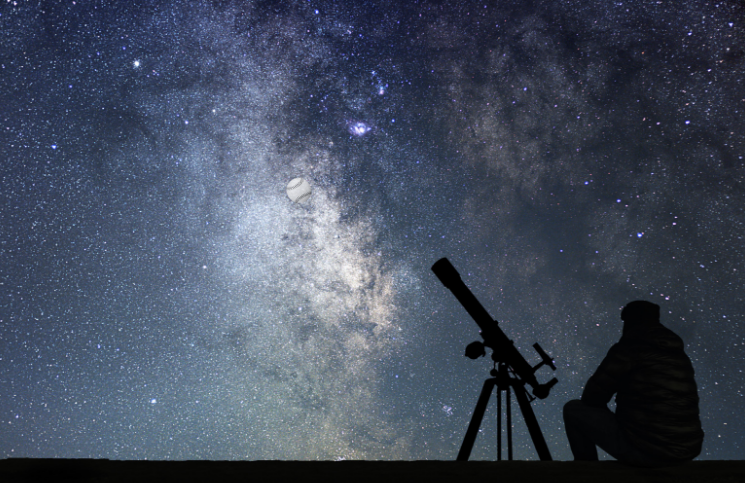Reading the Red Sox’ Stars
by Greg Cunningham, Blended Learning Specialist
- “I’m amazed you can see Venus with all the lights around Boston,” my friend Tyler commented as we walked back to the car after a Red Sox win at Fenway Park.
“That’s not Venus,” I assured him. “That’s Mars.”
“It can’t be Mars. It’s too bright to be Mars.”
“Actually, Mars is at its brightest point in 50 years right now. And the only time you can see Venus is right after sunset or right before sunrise. It’s too late for Venus.”
It was a variant of a conversation I’ve had with many friends about stars and planets, tapping knowledge of the heavens that dates back to college. I can recall little of what I studied or pretended to study at Stonehill College, but what I experienced in one class still resonates and I find myself applying its lessons to this day.
My sophomore general education science course was titled “The Great Clockwork.” It was a study of the constellations, the planets, the stars and everything else that comprises our night sky. The only textbook was The Old Farmer’s Almanac which provided detailed information about the phases of the moon, the orbits of the stars, planets in retrograde and innumerable other tidbits to help us decipher the heavens.
Our homework often required me to stand outside my dorm at night and observe or measure the things I saw. It gave me an understanding of the phases of the moon, why constellations are visible during certain times of the year, and why planets sometimes appear to move backward in the sky (known as retrograde). If you ever really want to feel insignificant, take a look at different planets, constellations and the moon using a high powered telescope like the one in the Stonehill observatory. An evening field trip gave us front row views of the craters on the moon, the rings around Saturn, and even a moon circling Jupiter. It was a humbling experience.
Speaking of heights, college costs are soaring. One year at Stonehill now costs what four years did when I attended. The cost factor is driving many to question whether college is really worth the money. That’s a decision for each individual, but for me, an English major sitting in “The Great Clockwork,“ I learned things I never would have encountered on my own. I discovered our universe and developed an understanding of how vast and overwhelming it is. It gave me pause to consider just how insignificant my individual concerns were in comparison. It prompted me to step back and appreciate the wonder surrounding us.
During that same semester, by sheer coincidence, I read a Walt Whitman poem in my 19th Century American Literature course:

Until that moment, I had never felt so connected to a piece of literature, and, by some virtue of self-understanding, connected to the universe as well. It was all right there for me to see.
Today, as I look over my college transcript, there are courses I don’t even remember taking, much less anything I might have learned from them. Other course titles spark flashes of remembered brilliance from intense but friendly professors, though what the brilliance illuminated now escapes me. So, what did I learn, besides random facts about stars and planets which may someday serve me well on Jeopardy, but now mainly serve to torment my friends and family? I learned to learn. I learned to observe a moment, to take in a poem, a play or a story and find the depth beneath the surface. I learned that contrary to our view from Earth, the universe is not black and white, nor are most earthly issues. I learned to exist, to coexist, and to discover. I learned that though my individual place in the universe is insignificant, yet the vastness of what is out there represents the vastness of what there is to learn. It’s as hard to put a price tag on such things as it is to explain them.
Maybe college is not for everyone. But if asked the value of general or liberal arts education in today’s technology-driven world, I would argue that it is more important than ever. The world we are actually living in now is not merely global: it is universal. We are already active in what used to be called outer space. Without context or understanding, it will be very easy for myopic human actors to lose sight of what we need to keep constantly in view. If it is our nature to be driven by our adventurist spirit in ceaseless pursuit of our insatiable dreams, we would do well to keep one eye turned to the sky, to remind us of our place in the expanse of the universe.
Stephen Crane understood where we stand in that relation:

Driving home from Fenway, Mars and Venus were forgotten in the heated rehashing of the game, the plays, the players, the coaches, the managers, the umpires and the revealed truth that the Red Sox season really begins in October. But then, as we sped along the dark ribbon of expressway, I spotted one final sign from the friendly universe: a shooting star!
As the meteor descended toward Logan, I summoned my deepest astronomical knowledge and identified it as the 10 PM Delta shuttle from LaGuardia. I understood the celestial signal. To the initiated, it was an unmistakable ballistic broadside from the Bronx, a taunting reminder of the nemesis that still stood athwart the Red Sox road to world championship.
Everyone’s a comedian. Even the universe. This time, the joke’s on them.
Greg Cunningham has been a Red Sox season ticket holder since 2004.
In case you missed it: ‘The Magic of Opening Day at Fenway Park’











